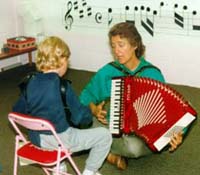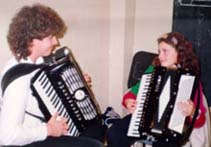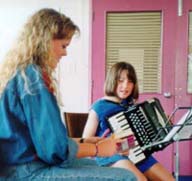 If you are a teacher and also a performer who spends many hours practicing
each week, you know without a doubt that there are two factors beyond genetics
that make you a competent musician. (1) you must practice many hours and
(2) you must use your time wisely. If this applies to the teacher it also
applies to the student, they must practice enough and must practice effectively.
If you are a teacher and also a performer who spends many hours practicing
each week, you know without a doubt that there are two factors beyond genetics
that make you a competent musician. (1) you must practice many hours and
(2) you must use your time wisely. If this applies to the teacher it also
applies to the student, they must practice enough and must practice effectively.No matter how good the lessons are the student is unsupervised almost 90% of the time. Teach your students to use their time wisely and they will find that practicing can be fun. In fact, efficient practice may well lead to more practice. Listed now are ten basic rules considered to be necessary for concrete constructive home practice. (1) Note the key signature and the time signature before you begin to play. (2) Work on the piece in sections or phrase by phrase at practice tempo. (3) If the rhythm is tricky, count! (4) Use correct, comfortable fingering, writing in any necessary changes. (5) Mark your music wherever you find you are making errors such as missing accidentals. (6) Test yourself. Three times right in a row, and you probably know the phrase or section. (7) Do a healthy amount of slow practice. (8) Make sure you allow time for thought and work on expression, phrasing, tone quality and bellows changes. (9) Listen to yourself, and try to match the sound you are making with the sound you are striving for. (10) After applying the above rules to new or difficult music, play some music you know well, do some sight reading, or play by ear, and have fun!  Of course these rules should not be handed to a student without discussion.
The average student is set in his practice method, and that method, nine
times out of ten, is to play the piece straight through, back up a few times
for missed notes, then play it again backing up for the same missed notes.
This type of practice virtually assures that the student will never play
the piece well, especially if the music is a challenge to his ability. It
is important that as you give the rules to a student, talk about them; write
them in his notebook. Time will be well spent on offering a short course
to your students on "How to practice effectively."
Of course these rules should not be handed to a student without discussion.
The average student is set in his practice method, and that method, nine
times out of ten, is to play the piece straight through, back up a few times
for missed notes, then play it again backing up for the same missed notes.
This type of practice virtually assures that the student will never play
the piece well, especially if the music is a challenge to his ability. It
is important that as you give the rules to a student, talk about them; write
them in his notebook. Time will be well spent on offering a short course
to your students on "How to practice effectively."An idea suggested in the article in relation to the first rule is as follows; a pianist, (or in our case accordionist), like an acrobat, must look before he leaps. No more plunging into a piece and missing a B flat or an F sharp in the first measure because you forgot to pay attention to the key signature. You may also expand on the rules a little. Teach students to watch for internal key changes, formal structure, tempo markings, and dynamic markings. This will give an idea of the style and mood for the piece before those fingers are set loose. To help remind your student to work on a piece in sections, mark "Thursday" at one spot on the music, "Saturday" some lines later etc… Tell a student you would far rather hear the first part of the piece played well than the whole piece played badly. Praise students for quality, not quantity.  You should also praise accuracy first, speed later. Students love to play
fast. Persist in your efforts to get them to slow down. Demonstrate to the
child how the passage goes when he plays it well, slowly. At the lesson
prove to him that after many slow repetitions, he will be able to speed
up and play the passage perfectly. There is no shortcut to learning difficult
music.To help your student learn phrasing and beautiful expression communicate
how much these aspects of music matter to you. Point out the markings on
the music, expect your students to follow them and praise them when they
do. A teacher must also encourage curiosity and scrupulous attention to
every little indication on the music.
You should also praise accuracy first, speed later. Students love to play
fast. Persist in your efforts to get them to slow down. Demonstrate to the
child how the passage goes when he plays it well, slowly. At the lesson
prove to him that after many slow repetitions, he will be able to speed
up and play the passage perfectly. There is no shortcut to learning difficult
music.To help your student learn phrasing and beautiful expression communicate
how much these aspects of music matter to you. Point out the markings on
the music, expect your students to follow them and praise them when they
do. A teacher must also encourage curiosity and scrupulous attention to
every little indication on the music.These rules listed in this article are, in a sense, guideposts that encourage your students to pay close attention to what they are doing. This following paragraph I feel sums up the article quite effectively as it highlights the importance for the teacher to be constantly aware that they are practicing what they are preaching. "Try these rules on yourself when you practice. You will find there is a bonus beyond more effective learning. Not only will you play better, you will also find it easier to stick to your work. Time flies when you are concentrating fully on what you are doing. Anyone who is practicing successfully will resent interruption and feel a wonderful sense of achievement at the close of the practice hour. Foster this in your students, and you will foster that positive attitude towards your instrument that leads to a lifelong love of music." |